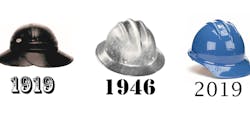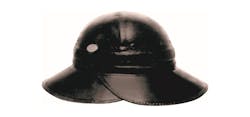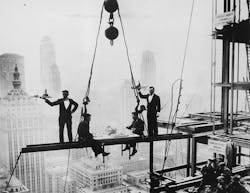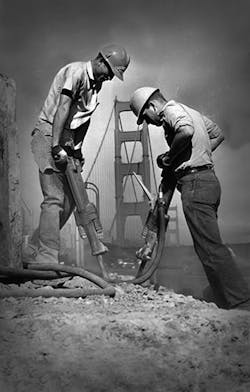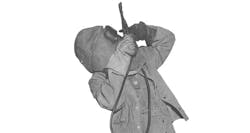Luckily for industrial workers everywhere, Lt. Edward Wheatley Bullard of the U.S. Cavalry climbed out of the French trenches with an idea that would spark the industrial safety movement: the hard hat.
Bullard, the son of a mining equipment supplier, was inspired by the metal helmets doughboys wore to deflect the hail of bullets raining down on them courtesy of the Kaiser. When he returned home, he invented the first commercially available industrial hard hat, called the Hard-Boiled hat.
Prior to its invention and subsequent production in San Francisco, gold and copper miners in California and Nevada basically wore leather caps—which might not be all that good at stopping hail, let alone the rocks or tools potentially pouring down on them.
Now one hundred years later, Bullard's great-granddaughter, current Bullard CEO Wells Bullard, recounts how this now 100-year-old equipment was invented and how it redefined protecting the workforce.
NED: What's the Hard-Boiled Hat's origin story?
Wells Bullard: My great grandfather, E.W. Bullard, was exposed to miners his whole life because his dad supplied them with equipment such as carbide lamps. When he was in the U.S. Cavalry during World War I, he wore one of those metal doughboy helmets in the trenches, so he came back and pointed out to his dad that miners were only wearing canvass caps at that point, and they faced very similar hazards to what he saw in the war. For miners, it was falling rock and ore, or tools dropped by workers higher up in the mine.
As an inventor, he was very user-focused and understood the miners couldn’t afford metal helmets. And metal was a lot heavier and they didn’t need to be protected against bullets. So he invented the Hard-Boiled Hat, which was made with steamed, or hard-boiled, canvass, leather, glue, and a very elementary suspension. It was shellacked with black paint.
NED: You still have a couple around. What does it feel like?
WB: People's heads were much smaller, due to nutrition, so you can’t wear the helmet. And it's not easy to adjust. It doesn’t easily ratchet-like modern helmets. The brim is just smooth leather, flexible but rigid. You could hear your hand knocking on it, but it flexes. The suspension was a piece of folded-over leather that went around the entire head, connected to a string that was tied into the top of the helmet. It feels very lightweight.
NED: What else can you say about the manufacturing?
WB:The factory was south of Market Street in San Francisco. In about 1925, Bullard put out an advertisement that celebrated the lowering of prices of the hard hats, and that was all because they know had machines. He had brought in machinery and automation, but I'm not sure if it was to help with the hard-boiling process or the sewing of components. I do think it was pretty incredible he used machines back then to scale up and then marketed them as a benefit for users, to keep prices down.NED: What was the perception of safety back then?
WB: OSHA didn’t come around until the early 1970s, so those first mining customers who used hard hats in the 1920s were really progressive employers because they thought about protecting their employees and thought about and really invested in safety. Back then workers were somewhat considered disposable; there was somebody else always ready to do the job if you couldn’t do it. It wasn't like today when you think about work-life balance.
NED: How did Bullard get involved with the construction of the Golden Gate Bridge in the 1930s?
WB: Bridge engineer Joseph B. Strauss was very safety-minded. At that point, for every $1 million of the bridge construction project, there was a death. And it was going to be an almost $40 million project. Strauss thought it was unacceptable to have 40 people die, so he implemented a whole bunch of safety provisions including firing people on the spot for "showboating.
It was very common for men working on these projects to do things that were pretty dangerous. It may have impressed coworkers, but Strauss had zero tolerance for that. He also implemented a safety net under the bridge that saved several lives. And he worked directly with my great grandfather to change the design of the hard hat a bit and reinforce it to protect against falling rivets.
Every worker on the bridge wore one, and it was the first designated construction area that required the use of hard hats. Strauss found his workers were much more efficient, productive, and effective because they were really confident. And there were no deaths due to head injuries from falling objects.
NED: How has the approach to safety evolved?
WB: The point of focus on safety in general trends toward not just focusing on immediate hazards but on long-term wellness and health. What are the effects of wearing something very heavy over time? You're thinking about the ergonomics and the wear and tear on bodies.
And in terms of comfort, there's been a lot of evolution. My great grandfather invented the first supplied-air respirator during the Golden Gate Bridge construction to protect workers sandblasting steel from breathing in these particles. It was canvass over a hard hat, with a window cut out and a piece of glass in there, along with a respirator. It was pretty elementary, but our respirator today has cooling and heating to allow workers to be more comfortable—allowing them to work safer and more comfortably.
The big change to hard hats is the availability of new materials that offer extreme durability and lightweight designs. Safety equipment is only effective when worn. In order for people to wear it, they have to be comfortable.
One thing that hasn’t changed is that we're still selling people peace of mind, so they could confidently go about their work.










